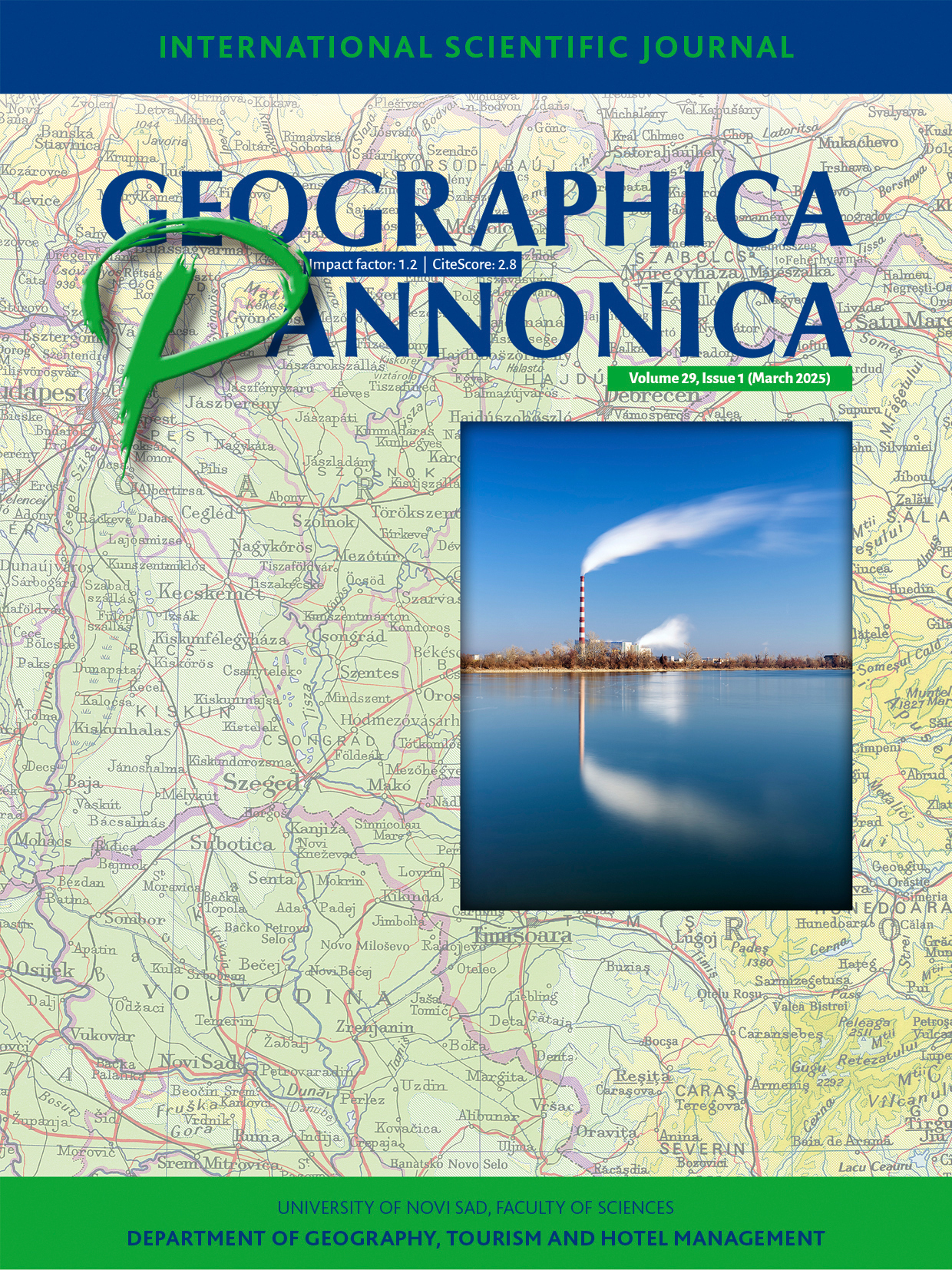Knowledge, Attitudes, and Practices Related to Heat Stress in the Climate of Koper and Ljubljana (Slovenia)
Abstract
This study examines the knowledge, attitudes, and practices related to heat stress among residents of two distinct urban neighbourhoods in Slovenia with different climate types: Olmo, Koper, and Zupančičeva jama, Ljubljana. The study explored the interplay of socio-economic indicators, demographic characteristics, and health status with heat stress KAP. While both locations demonstrated comparable levels of knowledge regarding heat stress, residents of Olmo exhibited significantly more positive attitudes towards adopting preventive measures and reported engaging in such behaviours more frequently. The findings suggest that targeted interventions must consider not only knowledge dissemination but also the unique characteristics of each community, including their specific climate, socio-economic profile, and cultural norms, to effectively enhance community resilience to the adverse impacts of heat stress.
References
Basu, R. (2009). High ambient temperature and mortality: A review of epidemiologic studies from 2001 to 2008. Environmental Health, 8(40). https://doi.org/10.1186/1476-069X-8-40
Bittner, M.-I., & Stößel, U. (2012). Perceptions of heatwave risks to health: Results of a qualitative interview study with older people and their carers in Freiburg, Germany. GMS Psychosocial Medicine, 9, Doc05. https://doi.org/10.3205/psm000083
Chandler, C. (2018). Knowledge, attitudes, and practice surveys. In The International Encyclopedia of Anthropology (p. 1). https://doi.org/10.1002/9781118924396.wbiea1387
Cornes, I. C., & Cook, B. (2018). Localising climate change: Heatwave responses in urban households. Disaster Prevention and Management, 27(2), 159–174. https://doi.org/10.1108/DPM-11-2017-0276
Franck, U., Krüger, M., Schwarz, N., Großmann, K., Röder, S., & Schlink, U. (2013). Heat stress in urban areas: Indoor and outdoor temperatures in different urban structure types and subjectively reported well-being during a heat wave in the city of Leipzig. E. Schweizerbart, 22(2), 167–177. https://doi.org/10.1127/0941-2948/2013/0384
Grothmann, T., Leitner, M., Glas, N., & Prutsch, A. (2017). A Five-Steps Methodology to Design Communication Formats That Can Contribute to Behavior Change: The Example of Communication for Health-Protective Behavior Among Elderly During Heat Waves. SAGE Open, 7(1). https://doi.org/10.1177/2158244017692014
Herrmann, A., & Sauerborn, R. (2018). General practitioners’ perceptions of heat health impacts on the elderly in the face of climate change—A qualitative study in Baden-Württemberg, Germany. International Journal of Environmental Research and Public Health, 15(5), 843. https://doi.org/10.3390/ijerph15050843
Ibrahim, J. E., McInnes, J. A., Andrianopoulos, N., & Evans, S. (2011). Minimising harm from heat waves: A survey of awareness, knowledge, and practices of health professionals and care providers in Victoria, Australia. Springer Science+Business Media, 57(2), 297–304. https://doi.org/10.1007/s00038-011-0243-y
Kajfež-Bogataj, L., Žnidaršič, Z., & Pogačar, T. (2018). Splošno poznavanje obremenitve z vročinskim stresom in možnih ukrepov [General knowledge of heat stress and possible measures]. Ujma: Revija za vprašanja varstva pred naravnimi in drugimi nesrečami, 32, 239–243.
Khare, S., Hajat, S., Kovats, S., Lefevre, C. E., Bruine de Bruin, W., Dessai, S., & Bone, A. (2015). Heat protection behaviour in the UK: Results of an online survey after the 2013 heatwave. BMC Public Health, 15, 878. https://doi.org/10.1186/s12889-015-2181-8
Kovats, R. S., & Hajat, S. (2008). Heat stress and public health: A critical review. Annual Review of Public Health, 29, 41–55. https://doi.org/10.1146/annurev.publhealth.29.020907.090843
Kunz-Plapp, T., Hackenbruch, J., & Schipper, J. W. (2016). Factors of subjective heat stress of urban citizens in contexts of everyday life. Natural Hazards and Earth System Sciences, 16, 977–994. https://doi.org/10.5194/nhess-16-977-2016
Lam, C. K. C., Gallant, A. J. E., & Tapper, N. J. (2018). Perceptions of thermal comfort in heatwave and non-heatwave conditions in Melbourne, Australia. Urban Climate, 23, 204–218. https://doi.org/10.1016/j.uclim.2017.11.003
Li, J., Xu, X., Ding, G., Zhao, Y., Zhao, R., Xue, F., Li, J., Gao, J., Yang, J., Jiang, B., & Liu, Q. (2016). A cross-sectional study of heat wave-related knowledge, attitude, and practice among the public in the Licheng District of Jinan City, China. International Journal of Environmental Research and Public Health, 13(7), 648. https://doi.org/10.3390/ijerph13070648
Nitschke, M., Hansen, A., Bi, P., Pisaniello, D., Newbury, J., Kitson, A., Tucker, G., Avery, J., & Dal Grande, E. (2013). Risk factors, health effects and behaviour in older people during extreme heat: A survey in South Australia. International Journal of Environmental Research and Public Health, 10(12), 6721–6733. https://doi.org/10.3390/ijerph10126721
Ogrin, D., Repe, B., Štaut, L., Svetlin, D., & Ogrin, M. (2023). Podnebna tipizacija Slovenije po podatkih za obdobje 1991–2020 [Climatic Typology of Slovenia Based on Data for the Period 1991–2020]. Dela, 59, 5–89. https://doi.org/10.4312/dela.59.5-89
Olmo. (2021). Statistical Office of Slovenia, STAGE. Retrieved from https://gis.stat.si/#lang=sl&tid=156&sid=7&vid=28733&p={"cm":0,"cb":5,"cp":"YlOrRd","cba":[null,2,3,4,5,9,10,24,25,null],"inverse_pallete_checkbox":false,"decimals":0}&z=14&o=0.7&c={"lat":45.531445204797244,"lng":13.715077154338362}
O'Neill, M. S., & Ebi, K. L. (2009). Temperature extremes and health: Impacts of climate variability and change in the United States. Journal of Occupational and Environmental Medicine, 51(1), 13–25. https://doi.org/10.1097/JOM.0b013e318173e122
Pan American Health Organization. (2021). Heat waves: A guide for health-based actions. Pan American Health Organization eBooks. https://doi.org/10.37774/9789275124086
Statistical Office of Slovenia. (2021). Zupančičeva jama. STAGE. Retrieved from https://gis.stat.si/#lang=sl&tid=411&sid=7&vid=20794&p={"cm":0,"cb":5,"cp":"YlOrRd","cba":[null,4,5,9,10,24,25,49,50,null],"inverse_pallete_checkbox":false,"decimals":0}&z=16&o=0.7&c={"lat":46.06063906731086,"lng":14.516524466453122}
Vandamme, E. (2009). Concepts and challenges in the use of Knowledge-Attitude-Practice surveys: Literature review (Vol. 1, pp. 1–7). Department of Animal Health, Institute of Tropical Medicine, Antwerp. Retrieved from https://www.scirp.org/reference/referencespapers?referenceid=1885577
World Health Organization (WHO), & Stop TB Partnership. (2008). Advocacy, communication and social mobilization for TB control: A guide to developing knowledge, attitude and practice surveys. World Health Organization.
Xu, X., Li, J., Gao, J., Liu, K., & Liu, Q. (2018). Effective analysis of a community-based intervention during heat waves to improve knowledge, attitude, and practice in a population in Licheng District, Jinan City, China. Journal of Public Health, 40(3), 573–581. https://doi.org/10.1093/pubmed/fdx121
Ye, H., Ma, J., Wu, Y., & Zhang, Y. (2018). Perceptions of health risks from hot weather, and coping behaviors among ethnic minority groups in mountain areas of China: A case study in the Tujia and Miao Autonomous Prefecture. International Journal of Environmental Research and Public Health, 15(11), 2498. https://doi.org/10.3390/ijerph15112498
Zhou, L., Xin, Z., Bai, L., Wan, F., Wang, Y., Sang, S., Liu, S., Zhang, J., & Liu, Q. (2014). Perceptions of heat risk to health: A qualitative study of professional bus drivers and their managers in Jinan, China. International Journal of Environmental Research and Public Health, 11(2), 1520-1535. https://doi.org/10.3390/ijerph110201520

